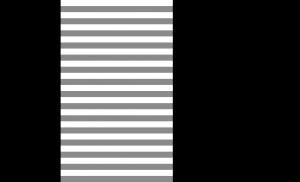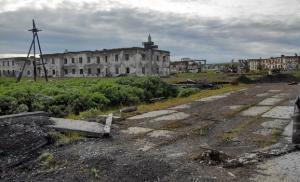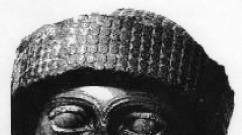Equation in molecular and ionic form. Molecular, complete and short ionic equations
11. Electrolytic dissociation. Ionic reaction equations
11.5. Ionic reaction equations
Since in aqueous solutions Since electrolytes break down into ions, it can be argued that reactions in aqueous solutions of electrolytes are reactions between ions. Such reactions can proceed either with a change in the oxidation state of atoms:
Fe 0 + 2 H + 1 Сl = Fe + 2 Сl 2 + H 0 2
and without change:
NaOH + HCl = NaCl + H2O
IN general case reactions between ions in solutions are called ionic, and if they are exchange reactions, then ion exchange reactions. Ion exchange reactions occur only when substances are formed that leave the reaction sphere in the form of: a) a weak electrolyte (for example, water, acetic acid); b) gas (CO 2, SO 2); c) sparingly soluble substance (precipitate). The formulas of sparingly soluble substances are determined from the solubility table (AgCl, BaSO 4, H 2 SiO 3, Mg(OH) 2, Cu(OH) 2, etc.). The formulas of gases and weak electrolytes need to be memorized. Note that weak electrolytes can be highly soluble in water: for example, CH 3 COOH, H 3 PO 4, HNO 2.
The essence of ion exchange reactions is reflected ionic reaction equations, which are obtained from molecular equations following the following rules:
1) the formulas of weak electrolytes, insoluble and slightly soluble substances, gases, oxides, hydroanions of weak acids (HS − , HSO 3 − , HCO 3 − , H 2 PO 4 − , HPO 4 2 − ; exception - HSO ion) are not written in the form of ions 4 – in a dilute solution); hydroxocations of weak bases (MgOH +, CuOH +); complex ions ( 3− , 2− , 2− );
2) the formulas of strong acids, alkalis, and water-soluble salts are represented in the form of ions. The formula Ca(OH) 2 is written as ions if lime water is used, but is not written as ions in the case of lime milk containing insoluble Ca(OH) 2 particles.
There are full ionic and abbreviated (short) ionic reaction equations. The abbreviated ionic equation is missing the ions present on both sides of the full ionic equation. Examples of writing molecular, full ionic and abbreviated ionic equations:
- NaHCO 3 + HCl = NaCl + H 2 O + CO 2 - molecular,
Na + + HCO 3 − + H + + Cl − = Na + + Cl − + H 2 O + CO 2 - complete ionic,
HCO 3 − + H + = H 2 O + CO 2 - abbreviated ionic;
- BaCl 2 + K 2 SO 4 = BaSO 4 ↓ + 2KCl - molecular,
Ba 2 + + 2 Cl − + 2 K + + SO 4 2 − = BaSO 4 ↓ + 2 K + + 2 Cl − - complete ionic,
Ba 2 + + SO 4 2 − = BaSO 4 ↓ - abbreviated ionic.
Sometimes the full ionic equation and the abbreviated ionic equation are the same:
Ba(OH) 2 + H 2 SO 4 = BaSO 4 ↓ + 2H 2 O
Ba 2+ + 2OH − + 2H + + SO 4 2 − = BaSO 4 ↓ + 2H 2 O,
and for some reactions the ionic equation cannot be compiled at all:
3Mg(OH) 2 + 3H 3 PO 4 = Mg 3 (PO 4) 2 ↓ + 6H 2 O
Example 11.5. Indicate a pair of ions that may be present in complete ion-molecular equation
, if it corresponds to the abbreviated ionic-molecular equation
Ca 2 + + SO 4 2 − = CaSO 4 .
1) SO 3 2 − and H +; 3) CO 3 2 − and K + ; 2) HCO 3 − and K + ; 4) Cl− and Pb 2+.
Solution. The correct answer is 2):
Ca 2 + + 2 HCO 3 − + 2 K + + SO 4 2 − = CaSO 4 ↓ + 2 HCO 3 − + 2 K + (Ca(HCO 3) 2 salt is soluble) or Ca 2+ + SO 4 2 − = CaSO4.
For other cases we have:
1) CaSO 3 + 2H + + SO 4 2 − = CaSO 4 ↓ + H 2 O + SO 2 ;
3) CaCO 3 + 2K + + SO 4 2 − (reaction does not occur);
4) Ca 2+ + 2Cl − + PbSO 4 (reaction does not occur).
Answer: 2).
Substances (ions) that react with each other in an aqueous solution (i.e., the interaction between them is accompanied by the formation of a precipitate, gas or weak electrolyte) cannot coexist in an aqueous solution in significant quantities
Table 11.2
Examples of ion pairs that do not exist together in significant quantities in aqueous solution
Example 11.6.
Indicate in this row: HSO 3 − , Na + , Cl − , CH 3 COO − , Zn 2+ - formulas of ions that cannot be present in significant quantities: a) in an acidic environment; b) in an alkaline environment.
Solution. a) In an acidic environment, i.e. together with H + ions, the anions HSO 3 − and CH 3 COO − cannot be present, since they react with hydrogen cations, forming a weak electrolyte or gas:
CH 3 COO − + H + ⇄ CH 3 COOH
HSO 3 − + H + ⇄ H 2 O + SO 2
b) HSO 3 − and Zn 2+ ions cannot be present in an alkaline medium, since they react with hydroxide ions to form either a weak electrolyte or a precipitate:
HSO 3 − + OH − ⇄ H 2 O + SO 3 2 −
Residues of acid salts of weak acids cannot be present in significant quantities in either an acidic or an alkaline medium, because in both cases a weak electrolyte is formed
The same can be said about the residues of basic salts containing a hydroxo group:
CuOH + + OH − = Cu(OH) 2 ↓
Instructions
Consider an example of the formation of a sparingly soluble compound.
Na2SO4 + BaCl2 = BaSO4 + 2NaCl
Or an ionic version:
2Na+ +SO42- +Ba2++ 2Cl- = BaSO4 + 2Na+ + 2Cl-
When solving ionic equations, the following rules must be observed:
Identical ions from both parts are excluded;
It should be remembered that the sum of the electric charges on the left side of the equation must be equal to the sum of the electric charges on the right side of the equation.
Write ionic equations for the interaction between aqueous solutions of the following substances: a) HCl and NaOH; b) AgNO3 and NaCl; c) K2CO3 and H2SO4; d) CH3COOH and NaOH.
Solution. Write down the equations of interaction of these substances in molecular form:
a) HCl + NaOH = NaCl + H2O
b) AgNO3 + NaCl = AgCl + NaNO3
c) K2CO3 + H2SO4 = K2SO4 + CO2 + H2O
d) CH3COOH + NaOH = CH3COONa + H2O
Note that the interaction of these substances is possible, because the result is the binding of ions with the formation of either weak (H2O), or sparingly soluble substance (AgCl), or gas (CO2).
By excluding identical ions from the left and right sides of the equality (in the case of option a) - ions and , in case b) - sodium ions and -ions, in case c) - potassium ions and sulfate ions), d) - sodium ions, you get solving these ionic equations:
a) H+ + OH- = H2O
b) Ag+ + Cl- = AgCl
c) CO32- + 2H+ = CO2 + H2O
d) CH3COOH + OH- = CH3COO- + H2O
Quite often in independent and tests There are tasks that involve solving reaction equations. However, without some knowledge, skills and abilities, even the simplest chemical equations don't write.
Instructions
First of all, you need to study the basic organic and inorganic compounds. As a last resort, you can have a suitable cheat sheet in front of you that can help during the task. After training they will still be remembered necessary knowledge and skills.
The basic material is covering, as well as methods for obtaining each compound. They are usually presented in the form general schemes, for example: 1. + base = salt + water
2. acid oxide + base = salt + water
3. basic oxide + acid = salt + water
4. metal + (diluted) acid = salt + hydrogen
5. soluble salt + soluble salt = insoluble salt + soluble salt
6. soluble salt + = insoluble base + soluble salt
Having before your eyes a table of salt solubility, and, as well as cheat sheets, you can decide on them equations reactions. It is only important to have full list such schemes, as well as information about the formulas and names of various classes of organic and inorganic compounds.
After the equation itself is completed, it is necessary to check the correctness of the spelling of the chemical formulas. Acids, salts and bases are easily checked using the solubility table, which shows the charges of the acidic residues and metal ions. It is important to remember that any one must be generally electrically neutral, that is, the number of positive charges must coincide with the number of negative ones. In this case, it is necessary to take into account the indices, which are multiplied by the corresponding charges.
If this stage has been passed and you are confident in the correctness of the spelling equations chemical reactions, then you can now safely set the coefficients. Chemical equation represents a conditional record reactions using chemical symbols, indices and coefficients. At this stage of the task, you must adhere to the rules: The coefficient is placed in front of the chemical formula and applies to all elements that make up the substance.
The index is placed after chemical element slightly below, and refers only to the chemical element to the left of it.
If a group (for example, an acid residue or a hydroxyl group) is in brackets, then you need to understand that two adjacent indices (before and after the bracket) are multiplied.
When counting the atoms of a chemical element, the coefficient is multiplied (not added!) by the index.
Next, the amount of each chemical element is calculated so that the total number of elements included in the starting substances coincides with the number of atoms included in the compounds formed in the products reactions. By analyzing and applying the above rules, you can learn to solve equations reactions included in chains of substances.
Most chemical reactions take place in solutions. Electrolyte solutions contain ions, so reactions in electrolyte solutions actually come down to reactions between ions.
Reactions between ions are called ionic reactions, and the equations for such reactions are called ionic equations.
When drawing up ionic equations, one should be guided by the fact that the formulas of slightly dissociating, insoluble and gaseous substances are written in molecular form.
A white substance precipitates, then an arrow pointing downward is placed next to its formula, and if a gaseous substance is released during the reaction, an arrow pointing upward is placed next to its formula.
Let's rewrite this equation, depicting strong electrolytes in the form of ions, and reactions leaving the sphere as molecules:
We have thus written down the complete ionic equation of the reaction.
If we exclude identical ions from both sides of the equation, that is, those not participating in the reaction in the left and right equations), we obtain a shortened ionic reaction equation: ![]()

Thus, the abbreviated ionic equations are the equations in general view, which characterize the essence of a chemical reaction, show which ions react and what substance is formed as a result.
Ion exchange reactions proceed to completion in cases where either a precipitate or a slightly dissociating substance, such as water, is formed. When adding an excess of nitric acid solution to a solution of sodium hydroxide colored crimson with phenolphthalein, the solution will become discolored, which will serve as a signal for a chemical reaction to occur: 
It shows that the interaction of a strong acid and alkali is reduced to the interaction of H+ ions and OH - ions, as a result of which a low-dissociation substance is formed - water.
This reaction between a strong acid and an alkali is called a neutralization reaction. This is a special case of an exchange reaction.
Such an exchange reaction can occur not only between acids and alkalis, but also between acids and insoluble bases. For example, if you obtain a blue precipitate of insoluble copper (II) hydroxide by reacting copper II sulfate with alkali:

and then divide the resulting precipitate into three parts and add a solution of sulfuric acid to the precipitate in the first test tube, a solution of hydrochloric acid to the precipitate in the second test tube, and a solution of nitric acid to the precipitate in the third test tube, then the precipitate will dissolve in all three test tubes. This will mean that in all cases it has passed chemical reaction, the essence of which is reflected using the same ionic equation.
To verify this, write down the molecular, complete and abbreviated ionic equations of the given reactions.
Let's consider ion reactions, which flow with the formation of gas. Pour 2 ml of solutions of sodium carbonate and potassium carbonate into two test tubes. Then pour a solution of hydrochloric acid into the first, and nitric acid into the second. In both cases, we will notice a characteristic “boiling” due to the released carbon dioxide. Let us write down the reaction equations for the first case: 
Reactions occurring in electrolyte solutions are described using ionic equations. These reactions were called ion exchange reactions, since in solutions electrolytes exchange their ions. Thus, two conclusions can be drawn.
1. Reactions in aqueous solutions of electrolytes are reactions between ions, and therefore are depicted in the form of ionic equations.
They are simpler than molecular ones and are more general in nature.
2. Ion exchange reactions in electrolyte solutions proceed practically irreversibly only if the result is the formation of a precipitate, gas or slightly dissociating substance.
7. Complex connections
Balance the complete molecular equation. Before writing the ionic equation, the original molecular equation must be balanced. To do this, it is necessary to place the appropriate coefficients in front of the compounds, so that the number of atoms of each element on the left side is equal to their number on the right side of the equation.
- Write the number of atoms of each element on both sides of the equation.
- Add coefficients in front of the elements (except oxygen and hydrogen) so that the number of atoms of each element on the left and right sides of the equation is the same.
- Balance the hydrogen atoms.
- Balance the oxygen atoms.
- Count the number of atoms of each element on both sides of the equation and make sure it is the same.
- For example, after balancing the equation Cr + NiCl 2 --> CrCl 3 + Ni, we get 2Cr + 3NiCl 2 --> 2CrCl 3 + 3Ni.
Determine what state each substance that participates in the reaction is in. This can often be judged by the conditions of the problem. Eat certain rules, which help determine what state an element or connection is in.
Determine which compounds dissociate (separate into cations and anions) in solution. Upon dissociation, a compound breaks down into positive (cation) and negative (anion) components. These components will then enter the ionic equation of the chemical reaction.
Calculate the charge of each dissociated ion. Remember that metals form positively charged cations, and non-metal atoms turn into negative anions. Determine the charges of elements using the periodic table. It is also necessary to balance all charges in neutral compounds.
Rewrite the equation so that all soluble compounds are separated into individual ions. Anything that dissociates or ionizes (such as strong acids) will split into two separate ions. In this case, the substance will remain in a dissolved state ( rr). Check that the equation is balanced.
- Solids, liquids, gases, weak acids and ionic compounds with low solubility will not change their state and will not separate into ions. Leave them as is.
- The molecular compounds will simply disperse into the solution and their state will change to dissolved ( rr). There are three molecular compounds that Not will go into state ( rr), this is CH 4( G) , C 3 H 8 ( G) and C8H18( and) .
- For the reaction under consideration, the complete ionic equation will be written in the following form: 2Cr ( TV) + 3Ni 2+ ( rr) + 6Cl - ( rr) --> 2Cr 3+ ( rr) + 6Cl - ( rr) + 3Ni ( TV) . If chlorine is not part of the compound, it breaks down into individual atoms, so we multiplied the number of Cl ions by 6 on both sides of the equation.
Combine the same ions on the left and right sides of the equation. You can only cross out those ions that are completely identical on both sides of the equation (have the same charges, subscripts, etc.). Rewrite the equation without these ions.
- In our example, both sides of the equation contain 6 Cl - ions, which can be crossed out. Thus, we obtain a short ionic equation: 2Cr ( TV) + 3Ni 2+ ( rr) --> 2Cr 3+ ( rr) + 3Ni ( TV) .
- Check the result. The total charges of the left and right parts ionic equations must be equal.













